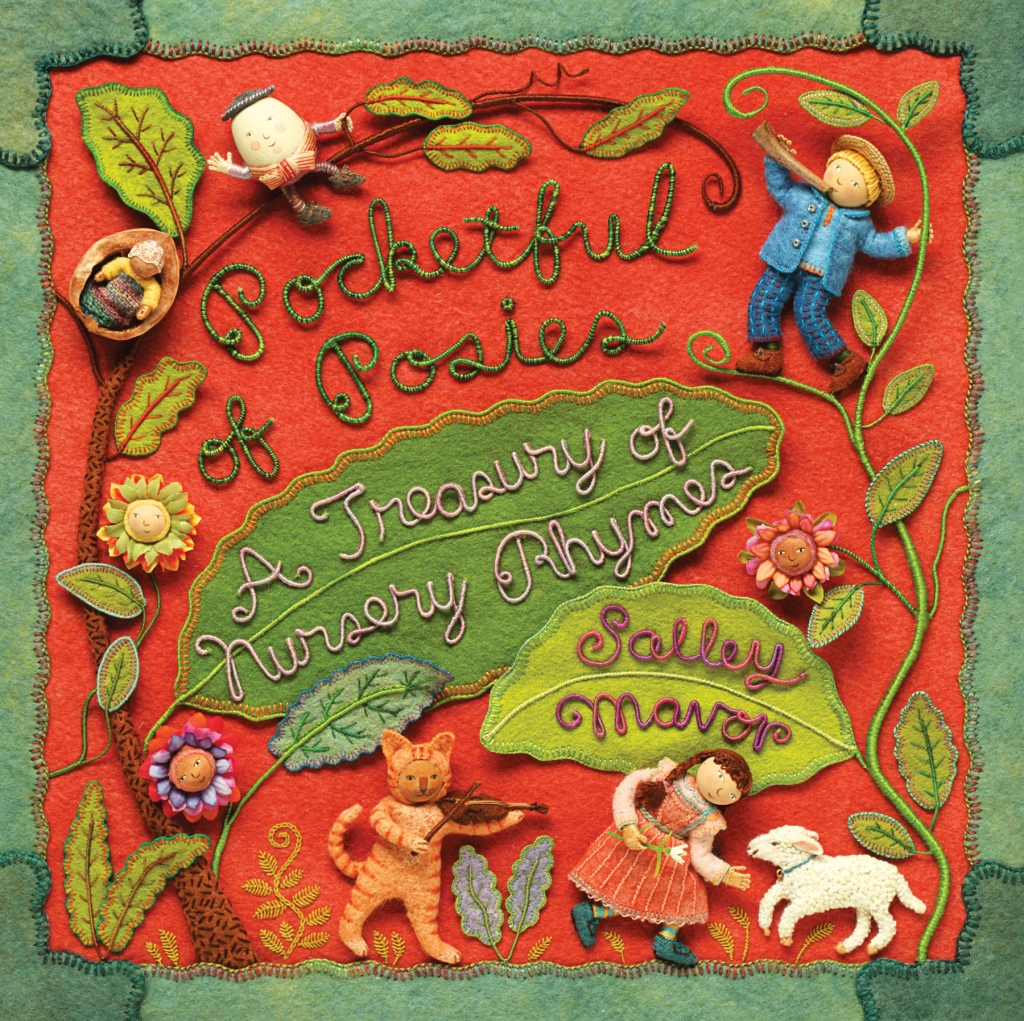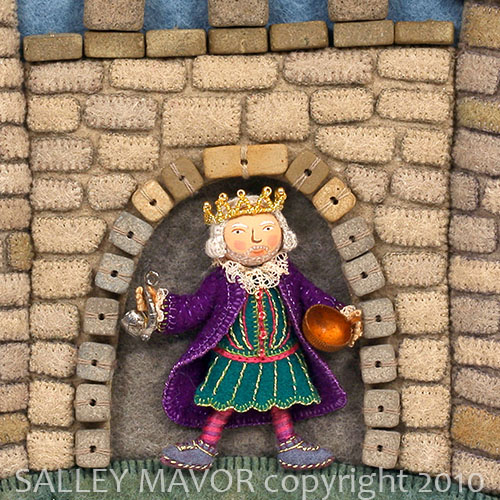I’m in love with wool felt! Aren’t you, too? Quite often, it’s my material of choice, along with embroidery thread. Once you use the wool variety, it’s hard to go back to handling the cheap acrylic type commonly found in craft stores. It’s like retiring your polyester pant suit in favor of cotton, wool or linen. Wool felt is seductive– it not only feels better, but has an integrity and durability not found in imitation fabrics. I primarily use wool felt that comes in sheets of different thicknesses.
People inquire about wool felt all the time, so I’ll address that right away. The cottage industry that made the plant dyed felt I used in the illustrations for Pocketful of Posies and My Bed no longer dyes felt.

Many online businesses sell wool felt, from garish commercially dyed colors to softer, plant dyed and “heather” shades. A Child’s Dream has a nice selection of premium quality 100% wool felt. Sweet Emma Jean sells a less expensive rayon/wool blend. The Olive Sparrow in Toronto, Canada offers a wide selection of wool felt. Of course, 100% wool felt is pricey, but it is certainly worth it. The doll clothes pattern pieces from my how-to book, Felt Wee Folk don’t require very much material, so a little can go a long way. If you want to try natural dying your own colors, take a look at this informative blog post from Willodell.

I want to clarify something — I use felt (noun) in my pieces. I do not make felt or do felting (verb). I don’t know why it bothers me, but my work is often described as “felted” when it is not. Felting has a rich history and has been around since ancient times. The verb to felt involves the manipulation and meshing of wool fleece fibers to form sheets of felt or 3-dimensional felted forms. Needle felting is immensely popular now-a-days, so I can see how the noun and verb are becoming interchangeable in some people’s minds. I’ve tried felting and think it’s fun, but find myself more interested in embroidering and decorating existing felt pieces.
Many of you have said that embellishing and stitching together little outfits is your favorite part of making the dolls from Felt Wee Folk. Women of a certain age have fond memories of sewing felt clothing for their Troll dolls during their first invasion in the 60’s. The later version of wide eyed Troll dolls where much cuter and not as appealing, in my opinion. I can still remember sewing snaps on my Troll clothes and trying to figure out whether to make the stitches jump from hole to hole or go outside the snap. I decided that it doesn’t matter which is the “right” way and tried both. Decades later, I’m still figuring out new ways to make and clothe little dolls and my early experience with making Troll clothes may have been what spurred me into writing how-to books.
To keep up with new posts, subscribe to this blog (top right column on the home page). Your contact info will not be sold or shared. If you’d like to see more frequent photos tracking the projects in my studio, please follow me on Facebook and/or Instagram.







Hi Salley,
I am one of those “women of a certain age” that used to dress her trolls and all sorts of other dolls as well, finding immense pleasure in creating theses and their accessories. My only trouble with using felt is that years later, even with stuff that has been enclosed in a box, often it ends up munched by some sort of invisible bugs. No signs of moths but pieces missing and sort of fluffed out fiber. This makes me hesitant to do much with wool felt. What to do you do to protect your treasures?
Ann
Hi Ann,
Yes, sometimes I have the same problem with munching bugs, but not on my illustrations, thank goodness. They are framed behind UV glass, which protects them from light, too. I have a large stash of felt , so to keep it moth free, I put it outside for a few days very winter when it gets below freezing. Small finished pieces can go inside your refrigerator freezer.
Perhaps others will write in with their suggestions.
Freezing wool materials is a great idea. In addition, I would then put wool items in a cedar chest (preferred) or one of those vacuum space-bags.
People are bringing so many natural materials into their homes these days and minute critters are hitch-hiking their way inside. You might not see the damage for months. P.S. Never stuff a draft-stopper with rice, unless you happen to enjoy pantry moths.
I wonder if putting it in the microwave would work…seems like a good use for a rarely used appliance. 😉
I have gorgeous wool felt from CraftyWoolFelt on etsy. I have also bought “upcycled” wool felt from AraucanaDesigns, also on etsy. I also buy old woolen clothes (woven and fine knits) at thrift stores, and felt them in the washing machine (hot wash, cold rinse). With woven, cut apart before felting. With knitted, felt first, then cut apart. I use all types, in various projects.
I absolutely love everything you do
I have been buying old wool coats and have been making my own
“felted wool.” (It’s an adjective there!)
I am definitely starting to worry about moths. I am getting cedar tomorrow, and I will absolutely be putting it out in the cold come winter.
I usually get some good felt of varying thicknesses. I’m limited in colors though, so I do have to buy some.